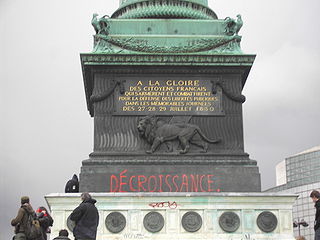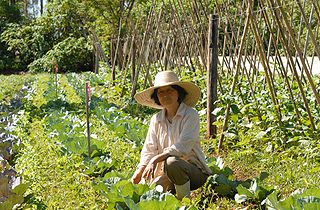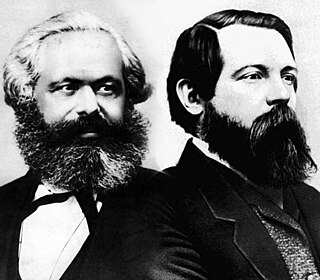 W
WEcological economics, bioeconomics, ecolonomy, or eco-economics, is both a transdisciplinary and an interdisciplinary field of academic research addressing the interdependence and coevolution of human economies and natural ecosystems, both intertemporally and spatially. By treating the economy as a subsystem of Earth's larger ecosystem, and by emphasizing the preservation of natural capital, the field of ecological economics is differentiated from environmental economics, which is the mainstream economic analysis of the environment. One survey of German economists found that ecological and environmental economics are different schools of economic thought, with ecological economists emphasizing strong sustainability and rejecting the proposition that physical (human-made) capital can substitute for natural capital.
 W
W2052 – A Global Forecast for the Next Forty Years is a 2012 book describing trends in global development. It is written by Jørgen Randers and is a follow-up to The Limits to Growth, which in 1972 was the first worldwide report by the Club of Rome.
 W
WThe Brando Resort is a private resort located on the atoll of Tetiaroa of the Society Islands in French Polynesia. The Brando serves as a regulated airstrip, research facility, eco-resort and spa on the islet (motu) of Onetahi. The resort consists of 80 staff and facilities management personnel. The atoll's inside, on which The Brando is located, is on a 99-year lease contracted by Marlon Brando.
 W
WA steady-state economy is an economy made up of a constant stock of physical wealth (capital) and a constant population size. In effect, such an economy does not grow in the course of time. The term usually refers to the national economy of a particular country, but it is also applicable to the economic system of a city, a region, or the entire world. Early in the history of economic thought, classical economist Adam Smith of the 18th century developed the concept of a stationary state of an economy: Smith believed that any national economy in the world would sooner or later settle in a final state of stationarity.
 W
WThe carrying capacity of an environment is the maximum population size of a biological species that can be sustained in that specific environment, given the food, habitat, water, and other resources available. In population ecology, carrying capacity is defined as the environment's maximal load, which is different from the concept of population equilibrium, which may be far below an environment's carrying capacity. The effect of carrying capacity on population dynamics may be modelled with a logistic function.
 W
WDegrowth is a term used for both a political, economic, and social movement as well as a set of theories that critiques the paradigm of economic growth. It is based on ideas from a diverse range of lines of thought such as political ecology, ecological economics, feminist political ecology, and environmental justice. Degrowth emphasizes the need to reduce global consumption and production and advocates a socially just and ecologically sustainable society with well-being replacing GDP as the indicator of prosperity. Degrowth highlights the importance of autonomy, care work, self-organization, commons, community, localism, work sharing, happiness and conviviality.
 W
WA steady-state economy is an economy made up of a constant stock of physical wealth (capital) and a constant population size. In effect, such an economy does not grow in the course of time. The term usually refers to the national economy of a particular country, but it is also applicable to the economic system of a city, a region, or the entire world. Early in the history of economic thought, classical economist Adam Smith of the 18th century developed the concept of a stationary state of an economy: Smith believed that any national economy in the world would sooner or later settle in a final state of stationarity.
 W
WDeep Economy: The Wealth of Communities and the Durable Future is a non-fiction work by environmentalist Bill McKibben published in the field of ecological economics in 2007. The work promoted sustainable economy in close-knit communities. These include regions that generate their own food, their own energy, their own culture, and their own entertainment. McKibben was interviewed by Salon.com, and was asked what a "deep economy" was. He defined it as one that "cares less about quantity than about quality; that takes as its goal the production of human satisfaction as much as surplus material; that is focused on the idea that it might endure and considers durability at least as important as increases in size." The book has been generally well-received, though some critics have questioned his proposed solutions.
 W
WThe Doughnut, or Doughnut economics, is a visual framework for sustainable development – shaped like a doughnut or lifebelt – combining the concept of planetary boundaries with the complementary concept of social boundaries. The name derives from the shape of the diagram, i.e. a disc with a hole in the middle. The centre hole of the model depicts the proportion of people that lack access to life's essentials while the crust represents the ecological ceilings that life depends on and must not be overshot. The diagram was developed by Oxford economist Kate Raworth in the Oxfam paper A Safe and Just Space for Humanity and elaborated upon in her book Doughnut Economics: Seven Ways to Think Like a 21st-Century Economist.
 W
WEcological Economics is a peer-reviewed academic journal published by Elsevier on behalf of the International Society for Ecological Economics. It covers research on ecological economics. The journal was established in 1989 by founding editor-in-chief Robert Costanza. The current editor-in-chief is Richard B. Howarth. The journal aims to "extend and integrate the study and management of nature's household (ecology) and humankind's household (economics)".
 W
WThe ecological footprint is a method promoted by the Global Footprint Network to measure human demand on natural capital, i.e. the quantity of nature it takes to support people or an economy. It tracks this demand through an ecological accounting system. The accounts contrast the biologically productive area people use for their consumption to the biologically productive area available within a region or the world. In short, it is a measure of human impact on the environment.
 W
WThe Economics of Ecosystems and Biodiversity (TEEB) was a study led by Pavan Sukhdev from 2007 to 2011. It is an international initiative to draw attention to the global economic benefits of biodiversity. Its objective is to highlight the growing cost of biodiversity loss and ecosystem degradation and to draw together expertise from the fields of science, economics and policy to enable practical actions. TEEB aims to assess, communicate and mainstream the urgency of actions through its five deliverables—D0: science and economic foundations, policy costs and costs of inaction, D1: policy opportunities for national and international policy-makers, D2: decision support for local administrators, D3: business risks, opportunities and metrics and D4: citizen and consumer ownership.
 W
WThe Economics of Land Degradation (ELD) Initiative is a global initiative which aims to increase awareness of the benefits of sustainable land management and economic consequences of land degradation. The ELD Initiative was co-founded in 2011 by the Secretariat of the United Nations Convention to Combat Desertification (UNCCD), the German Federal Ministry for Economic Cooperation and Development (BMZ), the European Commission (EC) and is hosted by the Deutsche Gesellschaft für Internationale Zusammenarbeit (GIZ) GmbH. The ELD Secretariat is based in Bonn, Germany.
 W
WEcosystem services are the many and varied benefits to humans provided by the natural environment and from healthy ecosystems. Such ecosystems include, for example, agroecosystems, forest ecosystems, grassland ecosystems and aquatic ecosystems. These ecosystems, functioning in healthy relationship, offer such things like natural pollination of crops, clean air, extreme weather mitigation, human mental and physical well-being. Collectively, these benefits are becoming known as 'ecosystem services', and are often integral to the provisioning of clean drinking water, the decomposition of wastes, and resilience and productivity of food ecosystems.
 W
WEcotourism is catering for tourists wishing to experience the natural environment without damaging it or disturbing its habitats. It is a form of tourism involving visiting fragile, pristine, and relatively undisturbed natural areas, intended as a low-impact and often small scale alternative to standard commercial mass tourism. It means responsible travel to natural areas, conserving the environment, and improving the well-being of the local people. Its purpose may be to educate the traveler, to provide funds for ecological conservation, to directly benefit the economic development and political empowerment of local communities, or to foster respect for different cultures and for human rights. Since the 1980s, ecotourism has been considered a critical endeavor by environmentalists, so that future generations may experience destinations relatively untouched by human intervention. Several university programs use this description as the working definition of ecotourism.
 W
WEmbodied energy is the sum of all the energy required to produce any goods or services, considered as if that energy was incorporated or 'embodied' in the product itself. The concept can be useful in determining the effectiveness of energy-producing or energy saving devices, or the "real" replacement cost of a building, and, because energy-inputs usually entail greenhouse gas emissions, in deciding whether a product contributes to or mitigates global warming. One fundamental purpose for measuring this quantity is to compare the amount of energy produced or saved by the product in question to the amount of energy consumed in producing it.
 W
WIn ecology, energy flow, also called the calorific flow, refers to the flow of energy through a food chain, and is the focus of study in ecological energetics. In an ecosystem, ecologists seek to quantify the relative importance of different component species and feeding relationships.
 W
WGenuine progress indicator (GPI) is a metric that has been suggested to replace, or supplement, gross domestic product (GDP). The GPI is designed to take fuller account of the well-being of a nation, only a part of which pertains to the size of the nation's economy, by incorporating environmental and social factors which are not measured by GDP. For instance, some models of GPI decrease in value when the poverty rate increases. The GPI separates the concept of societal progress from economic growth.
 W
WGross National Happiness is a philosophy that guides the government of Bhutan. It includes an index which is used to measure the collective happiness and well-being of a population. Gross National Happiness Index is instituted as the goal of the government of Bhutan in the Constitution of Bhutan, enacted on 18 July 2008.
 W
WThe Index of Sustainable Economic Welfare (ISEW) is an economic indicator intended to replace the Gross Domestic Product, which is the main macroeconomic indicator of System of National Accounts (SNA). Rather than simply adding together all expenditures like the gross domestic product, consumer expenditure is balanced by such factors as income distribution and cost associated with pollution and other unsustainable costs. It is similar to the Genuine Progress Indicator (GPI).
 W
WThe International Society for Ecological Economics (ISEE) was founded in 1989, based heavily on the work of Herman Daly to promote ecological economics and assist ecological economists and related societies. The society publishes a monthly journal Ecological Economics, books and other materials, and holds periodic meetings and conferences to facilitate a voice for ecological economists.
 W
WThe Limits to Growth (LTG) is a 1972 report on the exponential economic and population growth with a finite supply of resources, studied by computer simulation. Commissioned by the Club of Rome, the findings of the study were first presented at international gatherings in Moscow and Rio de Janeiro in the summer of 1971. The report's authors are Donella H. Meadows, Dennis L. Meadows, Jørgen Randers, and William W. Behrens III, representing a team of 17 researchers.
 W
WThe Mesoamerican Society for Ecological Economics (SMEE) is a regional chapter of the International Society for Ecological Economics (ISEE). After its foundation in 2008 at Guatemala City, the organization has already celebrated its first International Conference in 2010 at Mexico City and will carry out the second International Conference, EcoEco Alternatives, between March 4 and 8 2014 at the main campus of the University of Costa Rica.
 W
WNatural capital is the world's stock of natural resources, which includes geology, soils, air, water and all living organisms. Some natural capital assets provide people with free goods and services, often called ecosystem services. Two of these underpin our economy and society, and thus make human life possible.
 W
WThe Natural Capital Committee (NCC) is an independent body set up in 2012, initially for a three-year period, to report to the UK Government and advise on how to value nature and to ensure England's ‘natural wealth’ is managed efficiently and sustainably. During its first term it produced three reports to government on the 'State of Natural Capital'. It has called on the Office for National Statistics to integrate the state of the country's natural assets into mainstream national accounting.
 W
WThe Natural Capital Initiative (NCI) is a partnership of UK organisations which promotes and supports decision-making across government, business and the private sector that results in the sustainable management of our natural capital. Formed in 2009, it is a partnership between two of the UK's learned societies and two of its scientific research institutes, namely:Centre for Ecology and Hydrology Royal Society of Biology British Ecological Society James Hutton Institute.
 W
WA nutrient cycle is the movement and exchange of organic and inorganic matter back into the production of matter. Energy flow is a unidirectional and noncyclic pathway, whereas the movement of mineral nutrients is cyclic. Mineral cycles include the carbon cycle, sulfur cycle, nitrogen cycle, water cycle, phosphorus cycle, oxygen cycle, among others that continually recycle along with other mineral nutrients into productive ecological nutrition.
 W
WThe Russian Society for Ecological Economics (RSEE) is a regional chapter of the International Society for Ecological Economics (ISEE). It was established as the ISEE Russian Chapter in 1992.
 W
WSocial metabolism or socioeconomic metabolism is the set of flows of materials and energy that occur between nature and society, between different societies, and within societies. These human-controlled material and energy flows are a basic feature of all societies but their magnitude and diversity largely depend on specific cultures, or sociometabolic regimes. Social or socioeconomic metabolism is also described as "the self-reproduction and evolution of the biophysical structures of human society. It comprises those biophysical transformation processes, distribution processes, and flows, which are controlled by humans for their purposes. The biophysical structures of society and socioeconomic metabolism together form the biophysical basis of society."
 W
WA steady-state economy is an economy made up of a constant stock of physical wealth (capital) and a constant population size. In effect, such an economy does not grow in the course of time. The term usually refers to the national economy of a particular country, but it is also applicable to the economic system of a city, a region, or the entire world. Early in the history of economic thought, classical economist Adam Smith of the 18th century developed the concept of a stationary state of an economy: Smith believed that any national economy in the world would sooner or later settle in a final state of stationarity.
 W
WThermoeconomics, also referred to as biophysical economics, is a school of heterodox economics that applies the laws of statistical mechanics to economic theory. Thermoeconomics can be thought of as the statistical physics of economic value and is a subfield of econophysics.
 W
WUneconomic growth, in human development theory, welfare economics, and some forms of ecological economics, is economic growth that reflects or creates a decline in the quality of life. The concept is attributed to leading ecological economist and steady-state theorist Herman Daly, though other theorists can also be credited for the incipient idea. Note Uneconomic growth should not be confused with economic degrowth, the reduction of the size of the economy to increase well-being and sustainability.
 W
WUnequal exchange is a much disputed concept which is used primarily in Marxist economics, but also in ecological economics, to denote forms of exploitation hidden in or underwriting trade. Originating, in the wake of the debate on the Singer–Prebisch thesis, as an explanation of the falling terms of trade for underdeveloped countries, the concept was coined in 1962 by the Greco-French economist Arghiri Emmanuel to denote an exchange taking place where the rate of profit has been internationally equalised, but wage-levels have not. It has since acquired a variety of meanings, often linked to other or older traditions which perhaps then raise claims to priority.
 W
WAlthough related subjects, sustainable development and sustainability are different concepts. Weak sustainability is an idea within environmental economics which states that 'human capital' can substitute 'natural capital'. It is based upon the work of Nobel Laureate Robert Solow, and John Hartwick. Contrary to weak sustainability, strong sustainability assumes that "human capital" and "natural capital" are complementary, but not interchangeable.